
|
Now it is 12.8 mag (Jan. 16, Vance Petriew). It will brighten up to 11 mag from January to February. In the Northern Hemisphere, it stays observable for a long time in the evening sky. In the Southern Hemisphere, it locates extremely low at the highlight.
Date(TT) R.A. (2000) Decl. Delta r Elong. m1 Best Time(A, h)
Jan. 20 22 48.77 -5 59.7 1.411 0.941 41 11.4 18:44 ( 65, 22)
Jan. 27 23 21.30 -4 20.1 1.377 0.934 42 11.2 18:50 ( 67, 23)
|

|
Now it is very bright as 10.1 mag (Jan. 17, Maik Meyer). It will go far away from Earth after this. But it will approach to Sun down to 0.58 a.u. on Feb. 21. In the Northern Hemisphere, it will be getting lower rapidly after this, and it will be extremely low in February. In the Southern Hemisphere, it is not observable until late March.
Date(TT) R.A. (2000) Decl. Delta r Elong. m1 Best Time(A, h)
Jan. 20 22 20.07 39 5.2 0.495 0.912 66 11.2 18:44 (115, 38)
Jan. 27 22 2.49 31 53.5 0.669 0.808 54 11.4 18:50 (112, 26)
|

|
Now it is bright as 11.0 mag (Jan. 19, Sandor Szabo). It will stay bright as 11 mag for a long time until spring. In the Southern Hemisphere, it stays observable in good condition until February. In the Northern Hemispehre, it stays observable for a long time after this until the comet fades out.
Date(TT) R.A. (2000) Decl. Delta r Elong. m1 Best Time(A, h)
Jan. 20 4 6.13 19 43.8 2.182 2.848 123 11.2 20:07 ( 0, 75)
Jan. 27 4 2.04 21 43.0 2.245 2.819 116 11.3 19:36 ( 0, 77)
|

|
It brightened up to 9.2 mag from November to December (Nov. 16, Juan Jose Gonzalez). Now it is fading. But it is bright as 12.5 mag still now (Jan. 17, Chris Wyatt). It stays observable in good condition until summer when it fades out.
Date(TT) R.A. (2000) Decl. Delta r Elong. m1 Best Time(A, h)
Jan. 20 13 54.01 2 3.3 1.147 1.560 93 11.6 5:37 (351, 57)
Jan. 27 14 5.30 1 47.5 1.126 1.595 97 11.8 5:35 (357, 57)
|

|
It approached to Earth down to 0.07 a.u. in mid December, and it brightened up to 10.4 mag (Dec. 15, Thomas Lehmann). It approaches to Sun down to 0.14 a.u. on Jan. 25, but it is not observable.
Date(TT) R.A. (2000) Decl. Delta r Elong. m1 Best Time(A, h)
Jan. 20 19 48.01 -27 9.7 0.760 0.256 8 18.6 5:37 (291,-18)
Jan. 27 20 15.01 -19 43.8 1.109 0.157 5 11.9 5:35 (285,-14)
|

|
Now it is 13.1 mag (Jan. 17, Toshihiko Ikemura, Hirohisa Sato). It is expected to brighten up to 12 mag from 2018 to 2019. In the Northern Hemisphere, it stays observable in good condition while the comet will be brightening gradually. In the Southern Hemisphere, it is not observable until October.
Date(TT) R.A. (2000) Decl. Delta r Elong. m1 Best Time(A, h)
Jan. 20 15 47.25 59 19.9 3.004 3.248 95 13.1 5:37 (211, 57)
Jan. 27 15 46.21 62 8.4 2.911 3.209 98 12.9 5:35 (204, 58)
|

|
It brightened up to 8.1 mag in autumn (Oct. 3, Juan Jose Gonzalez). Now it is fading. It has already faded down to 14.2 mag (Jan. 15, Toshihiko Ikemura, Hirohisa Sato). It is observable all night in the Northern Hemisphere. In the Northern Hemisphere, it stays observable in excellent condition for a long time. In the Southern Hemisphere, it will never be observable again after this.
Date(TT) R.A. (2000) Decl. Delta r Elong. m1 Best Time(A, h)
Jan. 20 2 40.57 84 28.1 1.425 2.000 110 13.1 18:48 (180, 41)
Jan. 27 3 39.36 83 27.3 1.502 2.062 110 13.4 19:19 (180, 42)
|

|
It brightened up to 7.1 mag from May to June in 2017 (June 21, Juan Jose Gonzalez). Now it is fading. It has already faded down to 12.9 mag (Jan. 17, Chris Wyatt). In the Southern Hemisphere, it stays observable for a long time after this. However, it will be extremely low from January to March. It will never be observable again in the Northern Hemisphere.
Date(TT) R.A. (2000) Decl. Delta r Elong. m1 Best Time(A, h)
Jan. 20 21 52.91 -52 24.8 3.916 3.201 38 13.5 18:44 ( 38,-17)
Jan. 27 22 9.71 -51 32.9 3.990 3.267 37 13.6 18:50 ( 40,-19)
|
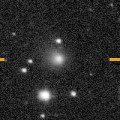
|
Now it is 14.1 mag (Dec. 13, Kunihiro Shima). It is expected to brighten up to 10 mag in summer in 2018. In the Northern Hemisphere, it stays observable until 2018 summer while the comet will be brightening. However, it will be extremely low from December to January. In the Southern Hemisphere, it will appear in the morning sky in late February, then it will be observable in good condition.
Date(TT) R.A. (2000) Decl. Delta r Elong. m1 Best Time(A, h)
Jan. 20 18 36.33 5 33.3 3.924 3.158 34 13.7 5:37 (274, 15)
Jan. 27 18 43.20 4 43.0 3.843 3.105 36 13.6 5:35 (277, 18)
|

|
Now it is 16.7 mag (Jan. 19, Jean-Francois Soulier).
Date(TT) R.A. (2000) Decl. Delta r Elong. m1 Best Time(A, h)
Jan. 20 21 48.88 -10 33.3 6.664 5.798 26 13.8 18:44 ( 72, 7)
Jan. 27 21 54.13 -10 2.3 6.708 5.797 20 13.9 18:50 ( 76, 2)
|

|
Now it is 13.8 mag (Jan. 17, Chris Wyatt). It stays 14 mag for a while. It stays observable in the evening sky until spring.
Date(TT) R.A. (2000) Decl. Delta r Elong. m1 Best Time(A, h)
Jan. 20 2 8.57 -30 40.0 1.933 2.013 80 14.2 18:44 ( 8, 24)
Jan. 27 2 17.26 -25 45.1 1.987 2.024 77 14.3 18:50 ( 15, 28)
|

|
Now it is 13.9 mag (Dec. 13, Kunihiro Shima). It will be observable at 14 mag for a long time from 2017 to 2018. In the Southern Hemisphere, it will be hardly observable after this.
Date(TT) R.A. (2000) Decl. Delta r Elong. m1 Best Time(A, h)
Jan. 20 16 36.55 26 49.0 3.970 3.739 69 14.3 5:37 (269, 50)
Jan. 27 16 37.03 28 32.2 3.874 3.735 74 14.2 5:35 (270, 56)
|

|
Now it is 12.7 mag (Jan. 17, Chris Wyatt). It will be fading after this.
Date(TT) R.A. (2000) Decl. Delta r Elong. m1 Best Time(A, h)
Jan. 20 15 29.31 -8 8.4 1.508 1.459 67 14.3 5:37 (322, 39)
Jan. 27 15 44.57 -9 4.6 1.506 1.509 71 14.9 5:35 (325, 39)
|

|
Brian Skiff found a bright outburst on Dec. 7. It brightened up to 13.2 mag (Dec. 11, Seiichi Yoshida). It stays bright as 14.6 mag still now (Jan. 19, Sandor Szabo). This is the 4th outburst following those in January 2006, May 2011 and August 2016. It stays observable in good condition for a while.
Date(TT) R.A. (2000) Decl. Delta r Elong. m1 Best Time(A, h)
Jan. 20 2 35.94 11 24.7 7.160 7.404 100 14.7 18:44 ( 4, 66)
Jan. 27 2 36.91 11 32.0 7.292 7.422 93 14.9 18:50 ( 23, 65)
|
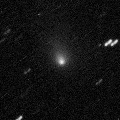
|
It brightened very rapidly up to 13.8 mag in August (Aug. 22, kunihiro Shima). After that, it is fading gradually. Now it is 15.5 mag (Jan. 12, Toshihiko Ikemura, Hirohisa Sato). It is observable in excellent condition in the Southern Hemisphere. It stays low for a while in the Northern Hemisphere.
Date(TT) R.A. (2000) Decl. Delta r Elong. m1 Best Time(A, h)
Jan. 20 0 40.75 -13 6.3 2.544 2.316 65 15.6 18:44 ( 36, 34)
Jan. 27 0 50.10 -10 58.2 2.597 2.296 61 15.7 18:50 ( 44, 33)
|
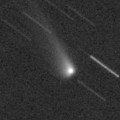
|
Now it is 15.9 mag (Dec. 28, Kunihiro Shima). It stays observable at 15-16 mag for a long time from 2017 to 2018.
Date(TT) R.A. (2000) Decl. Delta r Elong. m1 Best Time(A, h)
Jan. 20 0 11.03 -2 0.2 4.646 4.276 62 15.6 18:44 ( 52, 39)
Jan. 27 0 12.04 -2 31.1 4.767 4.280 55 15.7 18:50 ( 59, 33)
|
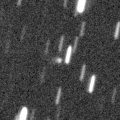
|
Now it is 15.9 mag (Jan. 13, Toshihiko Ikemura, Hirohisa Sato). It will brighten up to 9 mag in 2018 summer. However, it is hardly observable when it is bright. In the Northern Hemisphere, it is observable only until March when it brightens up to 14 mag. In the Southern Hemisphere, it is observable from July to September in 2018, but it locates in extremely low.
Date(TT) R.A. (2000) Decl. Delta r Elong. m1 Best Time(A, h)
Jan. 20 23 15.71 50 59.7 2.868 2.906 82 15.9 18:44 (130, 50)
Jan. 27 23 28.69 48 59.0 2.863 2.821 77 15.8 18:50 (127, 47)
|

|
Now it is 16.4 mag (Jan. 12, Toshihiko Ikemura, Hirohisa Sato). It stays 16-17 mag for a long time from 2016 to 2019. It stays near by the equator.
Date(TT) R.A. (2000) Decl. Delta r Elong. m1 Best Time(A, h)
Jan. 20 10 32.65 4 44.0 8.796 9.585 141 15.9 2:37 ( 0, 60)
Jan. 27 10 31.59 4 59.3 8.732 9.588 148 15.8 2:08 ( 0, 60)
|
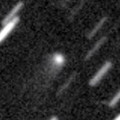
|
Now it is 15.3 mag (Jan. 19, Sandor Szabo). It stays 16 mag for a long time from 2017 to 2018. It is observable in excellent condition in the Northern Hemisphere. It locates very low in the Southern Hemisphere.
Date(TT) R.A. (2000) Decl. Delta r Elong. m1 Best Time(A, h)
Jan. 20 8 23.32 37 24.3 4.399 5.345 162 16.0 0:29 (180, 88)
Jan. 27 8 13.89 38 38.5 4.417 5.350 159 16.0 23:46 (180, 86)
|

|
Now it is 16.9 mag (Jan. 14, Toshihiko Ikemura, Hirohisa Sato). It stays 17 mag in 2018.
Date(TT) R.A. (2000) Decl. Delta r Elong. m1 Best Time(A, h)
Jan. 20 3 12.89 -0 26.1 6.145 6.474 105 16.1 19:14 ( 0, 55)
Jan. 27 3 13.76 -0 8.0 6.281 6.504 98 16.1 18:50 ( 1, 55)
|
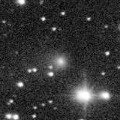
|
Now it is 15.8 mag (Jan. 14, Toshihiko Ikemura, Hirohisa Sato). It will be fading after this. In the Northern Hemisphere, it stays observable in the northern sky for a long time. It is not observable at all after this in the Southern Hemisphere.
Date(TT) R.A. (2000) Decl. Delta r Elong. m1 Best Time(A, h)
Jan. 20 20 27.34 64 11.8 3.367 3.416 84 16.1 18:44 (150, 30)
Jan. 27 20 35.92 65 15.9 3.403 3.440 83 16.1 5:35 (208, 28)
|

|
Now it is 16.1 mag (Jan. 15, Toshihiko Ikemura, Hirohisa Sato). It will be observable at 16 mag in good condition from winter to spring.
Date(TT) R.A. (2000) Decl. Delta r Elong. m1 Best Time(A, h)
Jan. 20 12 0.82 8 43.5 2.908 3.537 122 16.2 4:05 ( 0, 64)
Jan. 27 12 0.83 8 59.6 2.826 3.536 129 16.1 3:37 ( 0, 64)
|
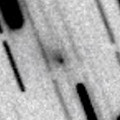
|
Mikhail Maslov reported that it looks bright as 13 mag with a large coma by his photo on Dec. 19. However, it is fading more rapidly than predicted after that. It has already faded down to 18.7 mag (Jan. 18, Toshihiko Ikemura, Hirohisa Sato). It will be getting lower after this, and it will be unobservable in February. It will appear in the morning sky in April. In the Southern Hemisphere, it will be observable at 16.5 mag in good condition from spring to summer. It will be low in the Northern Hemisphere.
Date(TT) R.A. (2000) Decl. Delta r Elong. m1 Best Time(A, h)
Jan. 20 22 49.62 14 48.1 2.017 1.629 53 16.1 18:44 ( 84, 34)
Jan. 27 22 49.38 12 27.7 2.136 1.601 45 16.2 18:50 ( 87, 26)
|
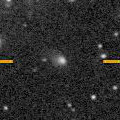
|
Now it is 15.8 mag (Dec. 25, Kunihiro Shima). It is expected to brighten up to 13-14 mag from 2018 to 2019. In the Northern Hemisphere, it stays observable in good condition for a long time. In the Southern Hemisphere, it is not observable until summer in 2018.
Date(TT) R.A. (2000) Decl. Delta r Elong. m1 Best Time(A, h)
Jan. 20 19 14.07 38 53.9 5.070 4.663 60 16.2 5:37 (238, 25)
Jan. 27 19 18.47 38 39.5 5.031 4.620 60 16.2 5:35 (241, 28)
|
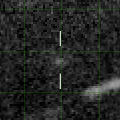
|
Now it is 17.4 mag (Dec. 18, Kim Breedlove). It will be observable at 14 mag in good condition from spring to summer.
Date(TT) R.A. (2000) Decl. Delta r Elong. m1 Best Time(A, h)
Jan. 20 16 37.56 -29 10.8 2.408 1.897 48 16.5 5:37 (320, 13)
Jan. 27 16 58.05 -29 49.1 2.326 1.864 50 16.2 5:35 (321, 13)
|

|
It stays 15 mag from 2018 to 2019, and it will be observable for a long time in the Southern Hemisphere. In the Northern Hemisphere, it will never be observable again.
Date(TT) R.A. (2000) Decl. Delta r Elong. m1 Best Time(A, h)
Jan. 20 14 4.82 -50 57.5 5.237 5.068 74 16.3 5:37 (355, 4)
Jan. 27 14 7.80 -52 28.1 5.116 5.032 79 16.3 5:35 (359, 2)
|
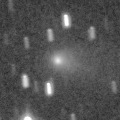
|
It brightened up to 14.8 mag from autumn to winter (Nov. 21, Hiroshi Abe). Now it is fading. It has already faded down to 16.2 mag (Jan. 18, Toshihiko Ikemura, Hirohisa Sato). It is observable in good condition in the Northern Hemisphere. It locates low in the Southern Hemisphere.
Date(TT) R.A. (2000) Decl. Delta r Elong. m1 Best Time(A, h)
Jan. 20 4 58.60 39 6.9 1.470 2.279 135 16.7 21:00 (180, 86)
Jan. 27 5 0.50 38 40.2 1.559 2.312 129 16.9 20:35 (180, 86)
|

|
Now it is 16.8 mag (Dec. 20, Toshihiko Ikemura, Hirohisa Sato). It will be observable at 16.5 mag in good condition in winter.
Date(TT) R.A. (2000) Decl. Delta r Elong. m1 Best Time(A, h)
Jan. 20 9 53.75 -14 14.3 2.202 2.996 136 16.7 1:58 ( 0, 41)
Jan. 27 9 50.21 -14 58.6 2.193 3.029 141 16.7 1:27 ( 0, 40)
|
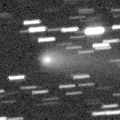
|
It brightened up to 12.2 mag in August (Aug. 21, Juan Jose Gonzalez). It is fading now. It has already faded down to 16.0 mag (Jan. 12, Toshihiko Ikemura, Hirohisa Sato).
Date(TT) R.A. (2000) Decl. Delta r Elong. m1 Best Time(A, h)
Jan. 20 7 31.95 17 45.4 1.467 2.444 171 16.7 23:32 ( 0, 73)
Jan. 27 7 25.00 18 42.1 1.541 2.500 163 17.0 22:58 ( 0, 74)
|

|
Now it is 16.5 mag (Jan. 18, Toshihiko Ikemura, Hirohisa Sato). It will pass the perihelion in 2019. However, it has not been brightening since the discovery in 2010. It is observable in good conditioin in the Northern Hemisphere. It is not observable for a long time in the Southern Hemisphere.
Date(TT) R.A. (2000) Decl. Delta r Elong. m1 Best Time(A, h)
Jan. 20 5 57.63 76 46.2 8.223 8.773 121 16.8 22:00 (180, 48)
Jan. 27 5 50.85 76 37.1 8.252 8.762 118 16.8 21:26 (180, 48)
|
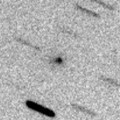
|
Now it is 17.1 mag (Dec. 21, Katsumi Yoshimoto). It stays observable at 17 mag in good condition for a while. It will be fainter than 18 mag in May.
Date(TT) R.A. (2000) Decl. Delta r Elong. m1 Best Time(A, h)
Jan. 20 14 43.48 -7 28.4 2.268 2.292 78 17.0 5:37 (335, 44)
Jan. 27 14 52.31 -7 45.5 2.214 2.325 83 17.0 5:35 (341, 45)
|

|
It will brighten up to 16 mag in spring. In the Southern Hemisphere, it stays observable until August, but it will be unobservable after that. In the Northern Hemisphere, it stays unobservable until June, but it will be observable in good condition after that.
Date(TT) R.A. (2000) Decl. Delta r Elong. m1 Best Time(A, h)
Jan. 20 16 30.47 -43 2.3 2.273 1.812 50 17.2 5:37 (329, 2)
Jan. 27 16 57.40 -44 39.0 2.177 1.755 52 17.1 5:35 (330, 1)
|

|
Now it is 16.8 mag (Jan. 12, Toshihiko Ikemura, Hirohisa Sato). In the Northern Hemisphere, it will be observable at 17 mag in excellent condition from autumn to winter. It locates low in the Southern Hemisphere.
Date(TT) R.A. (2000) Decl. Delta r Elong. m1 Best Time(A, h)
Jan. 20 5 0.91 35 5.0 2.547 3.331 136 17.1 21:02 (180, 90)
Jan. 27 5 0.30 34 47.1 2.637 3.352 129 17.2 20:34 ( 0, 90)
|

|
Now it is 17.0 mag (Jan. 18, Toshihiko Ikemura, Hirohisa Sato). It stays observable at 18 mag for a long time until 2019.
Date(TT) R.A. (2000) Decl. Delta r Elong. m1 Best Time(A, h)
Jan. 20 5 57.26 17 35.4 7.090 7.952 149 17.3 21:58 ( 0, 73)
Jan. 27 5 52.09 17 23.4 7.159 7.948 140 17.3 21:25 ( 0, 72)
|

|
It brightened up to 14.9 mag in autumn (Oct. 19, Catalina Sky Survey). Now it is fading rapidly. It has already faded down to 18.2 mag (Jan. 18, Toshihiko Ikemura, Hirohisa Sato).
Date(TT) R.A. (2000) Decl. Delta r Elong. m1 Best Time(A, h)
Jan. 20 1 18.72 19 0.9 2.998 3.086 85 17.3 18:44 ( 55, 66)
Jan. 27 1 25.40 19 33.1 3.109 3.102 80 17.4 18:50 ( 65, 61)
|
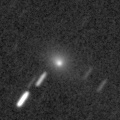
|
Return of a new periodic comet which brightened up to 13 mag in 2004. It brightened rapidly up to 14.3 mag (Nov. 15, Catalina Sky Survey). Now it is fading. It has already faded down to 18.0 mag (Jan. 12, Kunihiro Shima).
Date(TT) R.A. (2000) Decl. Delta r Elong. m1 Best Time(A, h)
Jan. 20 2 52.28 23 20.2 1.399 1.941 107 17.4 18:54 ( 0, 78)
Jan. 27 3 2.67 24 23.2 1.495 1.970 103 17.7 18:50 ( 15, 79)
|
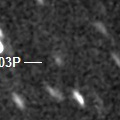
|
Now it is 18.4 mag (Jan. 15, Toshihiko Ikemura, Hirohisa Sato). It will be fading slowly after this.
Date(TT) R.A. (2000) Decl. Delta r Elong. m1 Best Time(A, h)
Jan. 20 12 1.48 -14 8.0 2.579 3.098 112 17.5 4:05 ( 0, 41)
Jan. 27 11 59.29 -14 11.1 2.534 3.148 120 17.5 3:36 ( 0, 41)
|
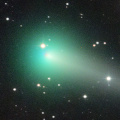
|
It brightened up to 6.2 mag in April (Apr. 7, Juan Jose Gonzalez). Now it is fading rapidly. It has already faded down to 16.3 mag (Jan. 14, Toshihiko Ikemura, Hirohisa Sato). It stays observable for a long time after this.
Date(TT) R.A. (2000) Decl. Delta r Elong. m1 Best Time(A, h)
Jan. 20 2 46.27 15 33.6 3.289 3.658 104 17.5 18:48 ( 0, 71)
Jan. 27 2 49.08 15 41.7 3.469 3.733 97 17.8 18:50 ( 19, 70)
|

|
Now it is 17.4 mag (Jan. 17, Toshihiko Ikemura, Hirohisa Sato). It was observed at 17 mag in former 2017. It will be observable at 18 mag in good condition from winter to spring.
Date(TT) R.A. (2000) Decl. Delta r Elong. m1 Best Time(A, h)
Jan. 20 12 51.32 6 42.0 4.963 5.380 110 17.8 4:55 ( 0, 62)
Jan. 27 12 48.80 7 59.4 4.868 5.401 117 17.8 4:25 ( 0, 63)
|

|
It was observed at 17 mag in 2017. It will be observable at 18 mag in 2018.
Date(TT) R.A. (2000) Decl. Delta r Elong. m1 Best Time(A, h)
Jan. 20 14 57.98 -20 56.1 6.381 6.141 71 17.9 5:37 (337, 31)
Jan. 27 15 0.53 -20 34.7 6.280 6.155 78 17.9 5:35 (343, 32)
|
|
![]()
 90P/Gehrels 1
90P/Gehrels 1 C/2015 XY1 ( Lemmon )
C/2015 XY1 ( Lemmon ) 47P/Ashbrook-Jackson
47P/Ashbrook-Jackson 355P/2017 M2 ( LINEAR-NEAT )
355P/2017 M2 ( LINEAR-NEAT ) 103P/Hartley 2
103P/Hartley 2 C/2015 ER61 ( PanSTARRS )
C/2015 ER61 ( PanSTARRS ) C/2017 D3 ( ATLAS )
C/2017 D3 ( ATLAS ) C/2017 E3 ( PanSTARRS )
C/2017 E3 ( PanSTARRS )![]()






































